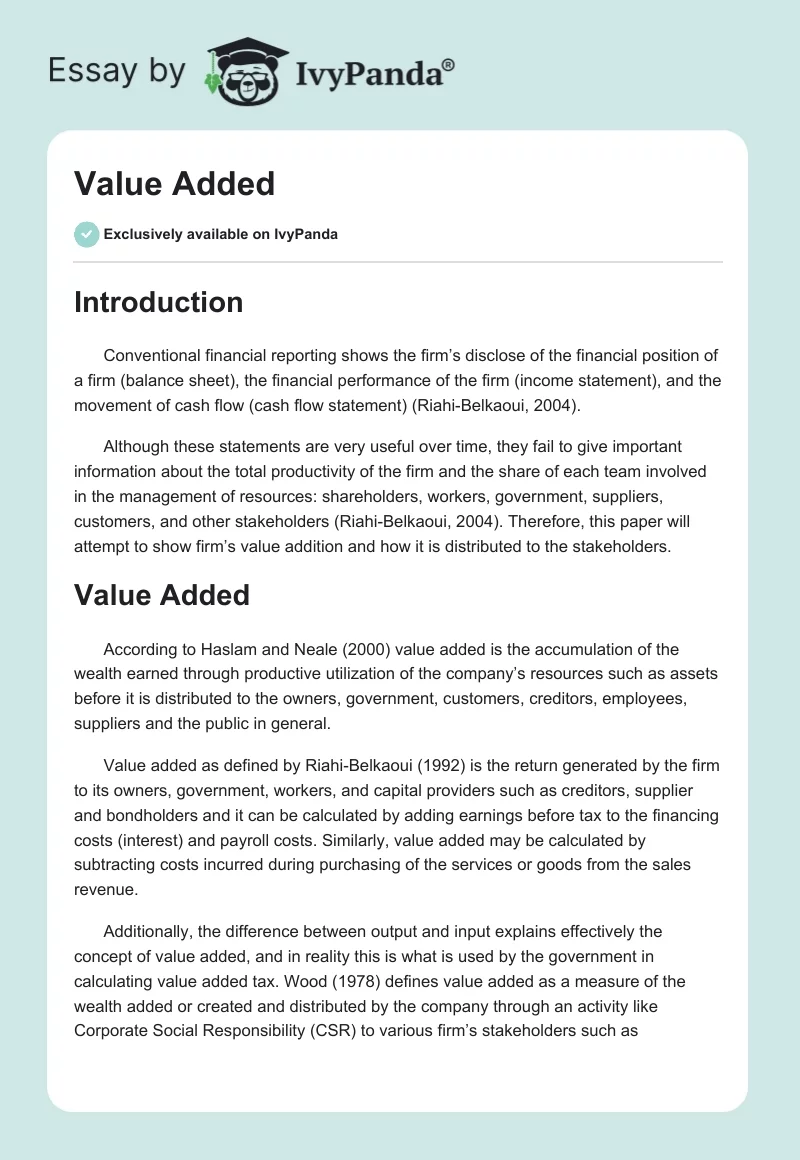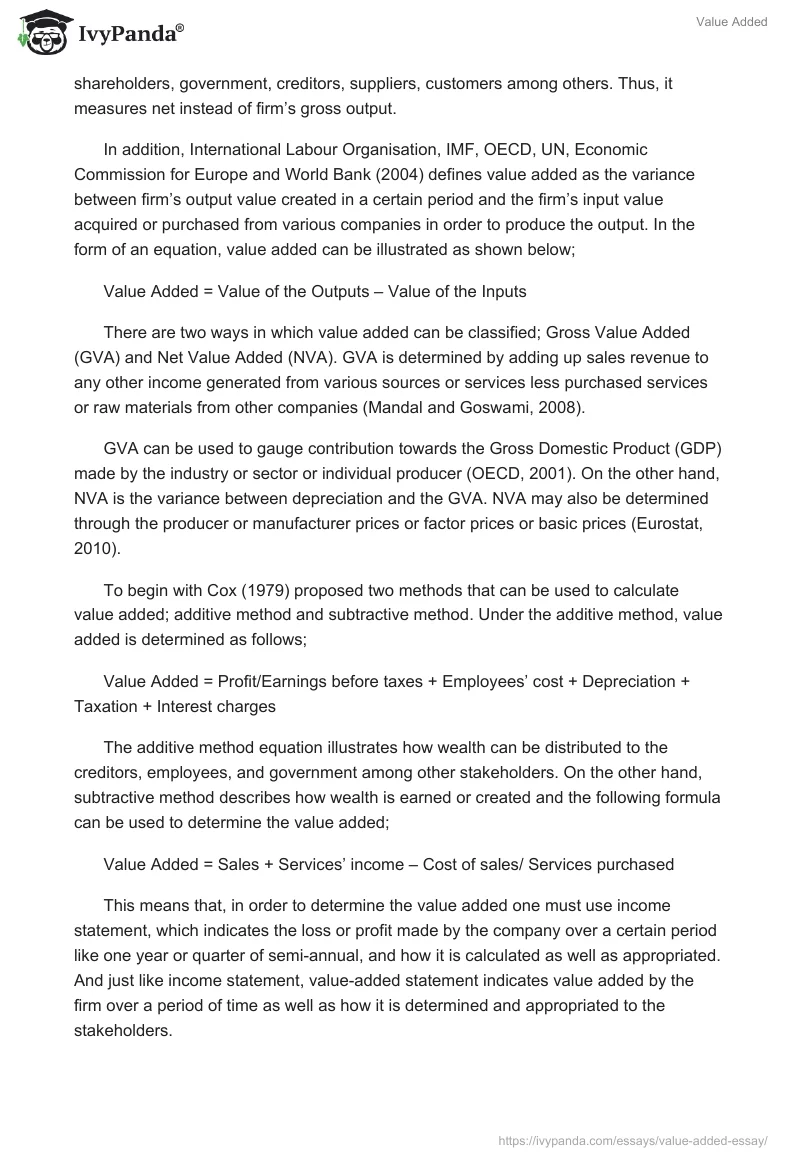Introduction
Conventional financial reporting shows the firm’s disclose of the financial position of a firm (balance sheet), the financial performance of the firm (income statement), and the movement of cash flow (cash flow statement) (Riahi-Belkaoui, 2004).
Although these statements are very useful over time, they fail to give important information about the total productivity of the firm and the share of each team involved in the management of resources: shareholders, workers, government, suppliers, customers, and other stakeholders (Riahi-Belkaoui, 2004). Therefore, this paper will attempt to show firm’s value addition and how it is distributed to the stakeholders.
Value Added
According to Haslam and Neale (2000) value added is the accumulation of the wealth earned through productive utilization of the company’s resources such as assets before it is distributed to the owners, government, customers, creditors, employees, suppliers and the public in general.
Value added as defined by Riahi-Belkaoui (1992) is the return generated by the firm to its owners, government, workers, and capital providers such as creditors, supplier and bondholders and it can be calculated by adding earnings before tax to the financing costs (interest) and payroll costs. Similarly, value added may be calculated by subtracting costs incurred during purchasing of the services or goods from the sales revenue.
Additionally, the difference between output and input explains effectively the concept of value added, and in reality this is what is used by the government in calculating value added tax. Wood (1978) defines value added as a measure of the wealth added or created and distributed by the company through an activity like Corporate Social Responsibility (CSR) to various firm’s stakeholders such as shareholders, government, creditors, suppliers, customers among others. Thus, it measures net instead of firm’s gross output.
In addition, International Labour Organisation, IMF, OECD, UN, Economic Commission for Europe and World Bank (2004) defines value added as the variance between firm’s output value created in a certain period and the firm’s input value acquired or purchased from various companies in order to produce the output. In the form of an equation, value added can be illustrated as shown below;
Value Added = Value of the Outputs – Value of the Inputs
There are two ways in which value added can be classified; Gross Value Added (GVA) and Net Value Added (NVA). GVA is determined by adding up sales revenue to any other income generated from various sources or services less purchased services or raw materials from other companies (Mandal and Goswami, 2008).
GVA can be used to gauge contribution towards the Gross Domestic Product (GDP) made by the industry or sector or individual producer (OECD, 2001). On the other hand, NVA is the variance between depreciation and the GVA. NVA may also be determined through the producer or manufacturer prices or factor prices or basic prices (Eurostat, 2010).
To begin with Cox (1979) proposed two methods that can be used to calculate value added; additive method and subtractive method. Under the additive method, value added is determined as follows;
Value Added = Profit/Earnings before taxes + Employees’ cost + Depreciation + Taxation + Interest charges
The additive method equation illustrates how wealth can be distributed to the creditors, employees, and government among other stakeholders. On the other hand, subtractive method describes how wealth is earned or created and the following formula can be used to determine the value added;
Value Added = Sales + Services’ income – Cost of sales/ Services purchased
This means that, in order to determine the value added one must use income statement, which indicates the loss or profit made by the company over a certain period like one year or quarter of semi-annual, and how it is calculated as well as appropriated. And just like income statement, value-added statement indicates value added by the firm over a period of time as well as how it is determined and appropriated to the stakeholders.
For instance, returns allocated to employees include salaries, wages and the staff expenses; to government include corporation tax and income tax; to shareholders is dividends; to business is retained profits; and financiers is the share capital’s dividends and interest on the loan. In simple terms, profit is determined by subtracting all business costs from sales.
While value added is variance between revenue obtained after selling the company’s product and services and raw materials costs purchased to manufacture these services or goods. Indeed, profit is the value added less the costs of value addition by the firm.
An Example
To show the Value-Added Statement Analysis, BT Plc is used as an example. The following table show the value added that is computed from the BT Plc financial statements for the period ended March 31, 2011. From the statement, the BT Plc’s value added is £10,355 million, which also applies to various stakeholders.
Table 1: BT Plc Value-Added Statement
The value-added concept is an important tool for appraising the firm’s performance whose operations have an effect on the economic and social well-being of the society. It recognises various contributors who have made contributions to the process of generating the value like the government, shareholders, financiers and employees. Relationship between value added, cash flow and profit and firm’s sales performance
A strong relationship exists between the firm’s financial statements, in that the value added, profit and cash flow are strongly related to the firm’s sales performance. First, the firm’s profit depends strongly on the firm’s sales performance as well as its target. This means that if the BT is not making any profit one would easily look at the firm’s sales budget and performance. And if sales performance is poor, this implies that the firm is making losses.
Conversely, in case the firm is more profitable this means that the firm sold more units and exceeded its budget. But at times high profit does not imply high sales. For instance, the firm may purchase products from the supplier at a lower price, with an expectation that it will sell the same to consumers in huge volumes at a higher price, thus expecting high profit. If the firm does not sell the expected volume, this means that the firm may end up with obsolete stock and losses (Heshmati and Loof, 2006).
BT Plc requires capital in order for it to survive as well as for it to undertake future investment in new assets. The cash is used to purchase resources used to manufacture services or goods, which are then sold. This process is known as cash-flow cycle, which involves the movement of firm’s incomes and expenditures for a period of time.
Cash flow as a vital part of the firm is linked with firm’s sales performance. In case the firm sells services or goods, the volume of sales determines how much is earned by the firm. Thus, if the firm is profitable, the firm’s sales performance is excellent resulting to extra addition of cash to cycle of the cash flow.
On the contrary, if firm’s sales performance is poor, the firm may be unable to put more cash to the cycle of cash flow as it had anticipated. Therefore, most businesses fail as a result of inadequate cash flow instead of profitability (Heshmati and Loof, 2006).
The value-added statement mirrors how BT Plc creates wealth and how wealth is distributed to the stakeholders. Revenue is generated when services or goods are sold, not when the cash is paid.
Hence, for credit sales, the time of sales is before the cash is required. The revenue can also be considered as the starting point for profit. However, the precise relationship is not necessarily linear that is every dollar of extra revenue does not necessarily translate to an extra dollar of profit for two main reasons: (1), the presence of indirect variable and fixed costs and taxes.
Different firms have different levels of gearing indirectly variable costs that normally vary non-linearly with the output, while the fixed costs, which are measured as a percentage of total costs are operating costs like rent, will be constant. Thus when sales increase, the profit will as well increase (Heshmati and Loof, 2006).
(2), as a business grows and increases its profit, it requires more capital. However, the cost of capital does not stay the same because of the amount of risk that capital providers perceive in investing in the company. This means that larger firms represent lower risk. Therefore, it can be seen that there is a non-linearity between profit and EVA and, hence, a non-linearity between sales and EVA (Referenceforbusiness, 2010).
Finally, net profit will turn into net cash flow, but over any time period there is a fluctuating relationship, which is largely influenced by economic circumstances. For example, during economic downturns, demand decreases and BT may be forced to delay payments to their suppliers as a result of decreased purchasing power.
References
Cox, B. 1979. Value added: An appreciation for the accountant concerned with industry. London: Heinemann. Print.
Eurostat. 2010. Glossary: Gross Value Added at market prices. Web.
Haslam, C. and Neale, A. 2000. Economic in a Business Context. London: Business press.
Heshmati, A. and Loof, H. 2006. Investment and performance of firms: Correlation or Casuality? CESIS Electronic Working Paper Series, Paper No.72. Web.
International Labour Organisation, IMF, OECD, UN, Economic Commission for Europe and World Bank. 2004. Producer price index manual: theory and practice. Washington DC: IMF.
Mandal, N. and Goswami, S. 2008. Value Added Statement (VAS) – A Critical Analysis: A case study of Bharat Heavy Electricals Limited. Great Lakes Herald, 2(2):98-120.
OECD. 2001. Gross Value Added. Web.
Referenceforbusiness. 2010. Economic Profit. Web.
Riahi-Belkaoui, A. 1992. Value added reporting: Lessons for the United States. New York: Greenwood Publishing Group. Print.
Riahi-Belkaoui, A. 2004. Accounting Theory, 5th edition. London: Cengage Learning EMEA. Reprint. Wood, E. 1978. Added value: The key to prosperity. London: Business Books.


